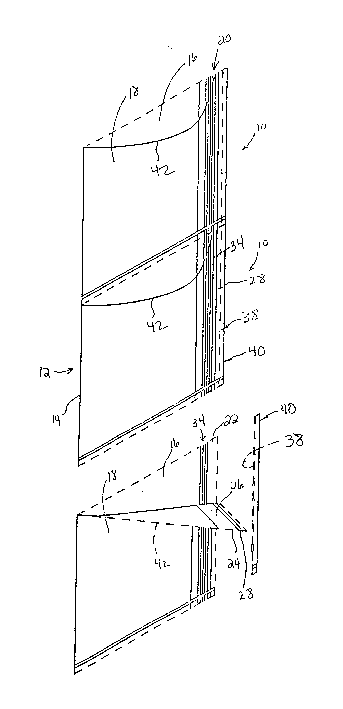Some of the information on this Web page has been provided by external sources. The Government of Canada is not responsible for the accuracy, reliability or currency of the information supplied by external sources. Users wishing to rely upon this information should consult directly with the source of the information. Content provided by external sources is not subject to official languages, privacy and accessibility requirements.
Any discrepancies in the text and image of the Claims and Abstract are due to differing posting times. Text of the Claims and Abstract are posted:
| (12) Patent Application: | (11) CA 2107384 |
|---|---|
| (54) English Title: | RECLOSABLE BAG WITH OFFSET END SEAL |
| (54) French Title: | SAC REFERMABLE MUNI D'UN DISPOSITIF DE SCELLEMENT EN RETRAIT A UNE EXTREMITE |
| Status: | Deemed Abandoned and Beyond the Period of Reinstatement - Pending Response to Notice of Disregarded Communication |
| (51) International Patent Classification (IPC): |
|
|---|---|
| (72) Inventors : |
|
| (73) Owners : |
|
| (71) Applicants : | |
| (74) Agent: | SMART & BIGGAR LP |
| (74) Associate agent: | |
| (45) Issued: | |
| (22) Filed Date: | 1993-09-30 |
| (41) Open to Public Inspection: | 1994-10-03 |
| Examination requested: | 1995-06-28 |
| Availability of licence: | N/A |
| Dedicated to the Public: | N/A |
| (25) Language of filing: | English |
| Patent Cooperation Treaty (PCT): | No |
|---|
| (30) Application Priority Data: | ||||||
|---|---|---|---|---|---|---|
|
ABSTRACT OF THE DISCLOSURE
The closable bag with offset end seal comprises a layer of
plastic folded over itself to create an elongate strip of
interconnected pockets which are separable from one another along
the strip to create individual bags. Interposed between free
overlying ends of the plastic strip is a gasket made of a heat
sealable material having a low surface tension and coefficient of
friction. A side edge of these three layers is heat sealed and
scored to provide a tamper indicating strip which must be removed
to open the bag. Slightly lateral to this strip is a section of
the bag where the gasket is heat sealed along its length to one of
the layers of plastic, with a remaining inwardly extending portion
of the gasket being free to move away from the layer to which it
sealed, creating an inwardly directed flap. On a surface of the
unattached layer of plastic facing the gasket are provided two
spaced apart longitudinal strips of adhesive which cause engagement
between the layer of plastic and the gasket flap. Thus, if product
within the bag moves toward the seal end of the bag, it rests
between the gasket flap and the layer of plastic to which it is
heat sealed, without directly resting against the area of closure
and compromising effectiveness thereof.
Note: Claims are shown in the official language in which they were submitted.
Note: Descriptions are shown in the official language in which they were submitted.

2024-08-01:As part of the Next Generation Patents (NGP) transition, the Canadian Patents Database (CPD) now contains a more detailed Event History, which replicates the Event Log of our new back-office solution.
Please note that "Inactive:" events refers to events no longer in use in our new back-office solution.
For a clearer understanding of the status of the application/patent presented on this page, the site Disclaimer , as well as the definitions for Patent , Event History , Maintenance Fee and Payment History should be consulted.
| Description | Date |
|---|---|
| Inactive: IPC from MCD | 2006-03-11 |
| Inactive: IPC from MCD | 2006-03-11 |
| Application Not Reinstated by Deadline | 1996-03-31 |
| Time Limit for Reversal Expired | 1996-03-31 |
| Inactive: Adhoc Request Documented | 1995-10-02 |
| Deemed Abandoned - Failure to Respond to Maintenance Fee Notice | 1995-10-02 |
| Request for Examination Requirements Determined Compliant | 1995-06-28 |
| All Requirements for Examination Determined Compliant | 1995-06-28 |
| Application Published (Open to Public Inspection) | 1994-10-03 |
| Abandonment Date | Reason | Reinstatement Date |
|---|---|---|
| 1995-10-02 |
Note: Records showing the ownership history in alphabetical order.
| Current Owners on Record |
|---|
| BARRIE A. BRAY |
| PAUL W. SCARBERRY |
| Past Owners on Record |
|---|
| None |